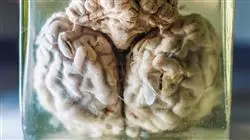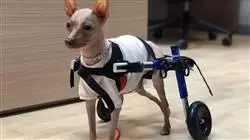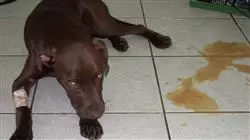University certificate
The world's largest faculty of veterinary medicine”
Description
Acquire the skills required to perform an accurate neurological examination of your patients, learning how to develop the differential diagnosis and to prescribe the most appropriate tests in each case"

In the last decade, Neurology in the field of Small Animals has experienced a great boom among veterinary professionals interested in this specialization.
Much of this interest is due to the access to new technologies by physicians, such as CT and MRI, machinery much more within the reach of veterinary centers and hospitals that allow more accurate diagnoses and facilitate a deeper understanding of the different pathologies.
The professional master’s degree in Small Animal Neurology is structured in modules to facilitate the detailed study of all aspects of clinical neurology: the anatomy and physiology of the nervous system, the location of the lesion, the different common pathologies in each anatomical region, diagnostic tests and their interpretation, as well as the treatment and prognosis of each disease..
This professional master’s degree places special emphasis on extrapolating theoretical concepts to the practice of the practitioner, allowing the veterinarian to face each clinical case with the personal knowledge and experience of the teachers, always from a scientific point of view: from the point of view of Evidence-Based Medicine.
It is designed for veterinarians who want to specialize in Small Animal Neurology, as well as for those professionals who are dedicated to this discipline and want to strengthen and expand their knowledge.
A study that includes knowledge of the anatomy and physiology of the nervous system, brain or spinal cord"
This professional master’s degree in Small Animal Neurology contains the most complete and up-to-date scientific program on the market. The most important features include:
- The latest technology in online teaching software
- A highly visual teaching system, supported by graphic and schematic contents that are easy to assimilate and understand
- Practical cases presented by practising experts
- State-of-the-art interactive video systems
- Teaching supported by telepractice
- Continuous updating and recycling systems
- Autonomous learning: full compatibility with other occupations
- Practical exercises for self-evaluation and learning verification
- Support groups and educational synergies: questions to the expert, debate and knowledge forums
- Communication with the teacher and individual reflection work
- Availability of content from any fixed or portable device with internet connection
- Banks of complementary documentation permanently available, even after the program
With the real experience of specialists in Small Animal Neurology who pour their authentic and practical vision of veterinary intervention in the field into this program"
The topics and clinical cases proposed, as well as their resolution, are based on the practical experience of the teachers and on the latest advances in research and development that nurture this field of work.
All information is presented through high-quality multimedia content, analysis of clinical cases prepared by teachers, master classes and video techniques that allow the exchange of knowledge and experience, maintain and update the skill level Educational of its members, create protocols for action and disseminate the most important developments in the emergencies within medicine of small animals.
TECH's teaching staff is made up of professionals from different fields related to this specialty. In this way we ensure that we deliver the educational update we are aiming for. A multidisciplinary team of trained and experienced professionals in different environments, who will develop the theoretical knowledge in an efficient way, but, above all, will put at the service of the program the practical knowledge derived from their own experience: one of the differential qualities of this professional master’s degree.
With a methodological design based on teaching techniques proven for their effectiveness, this highly qualified professional master’s degree is created to allow you to learn in a dynamic and effective way"

With the support of the most efficient audiovisual systems, the purpose of this program is that you not only acquire the knowledge, but that, upon completion, you will have the working skills you need in this field"
Objectives
This professional master’s degree compiles the most current knowledge in terms of scientific research and technological development in diagnostic techniques and intervention in neurological pathologies in small animals. The objective is to generate specialized knowledge in the student, creating a well-structured basis to identify the clinical signs associated with each neurological location and to be able to establish a list of differential diagnoses, acting correctly to achieve the best possible prognosis in patients.

The ultimate goal is to boost your capacity for real intervention by incorporating into your knowledge the most up-to-date knowledge in this field, learning in a realistic and effective way in order to grow as a professional"
General Objectives
- Examine the embryonic development of the nervous system in its different phases and the mechanisms involved in its training
- Determine, in an exhaustive manner, the different regions of the central nervous system, peripheral nervous system and musculoskeletal system
- Analyze the physiology and mechanism of the functioning of the central nervous system
- Identify the different vascular structures of clinical importance to identify possible vascular pathologies and learn about these structures in surgical procedures
- Perform a correct anamnesis and data collection
- Determine the steps of the neurological examination and its correct performance
- Identify the characteristic clinical signs depending on the site of the lesion
- Define the list of problems depending on the patient's course, clinical history and review
- Identify the different most common laboratory tests
- Compile the indications, performance and interpretation of advanced imaging tests
- Develop the principles of electrophysiology, the different tests and their interpretation
- Determine the correct performance of muscle and nerve biopsy
- Structure the different anesthetic protocols in neurosurgery
- Identify the different pathologies that require surgical intervention, as well as their technique
- Propose the appropriate analgesic management for each case
- Define the fundamentals of rehabilitation, its indications and the most appropriate techniques for each case
- Identify common clinical signs affecting the brain
- Analyze inflammatory and vascular diseases, various toxic, traumatic and metabolic diseases
- Compile and classify the most common neoplasms of the brain
- Reinforce concepts of localization and characteristic clinical signs of myelopathies
- Define and present the different etiologies in myelopathies
- Manage and treat the different types of herniated discs
- Analyze the different diagnostic tests required and their interpretation for the different causes of spinal cord pathologies
- Define and classify the different neuromuscular diseases
- Develop the different diagnostic tests and their interpretation
- Develop the different treatments for neuromuscular diseases
- Present the characteristic clinical signs for its correct neurolocalization
- Develop the different alterations of the cranial pairs
- Present vestibular syndrome, types and its management
- Define the different entities of movement disorders
- Deepen and develop the knowledge of neuro-ophthalmology
- Examine the most important syndromes in Small Animal Neurology
- Analyze the different alterations of urination
- Determine alternative therapies for neurological processes
- Deepen in the study and application of oncological treatments
- Analyze the management in anesthesia with a neurological emergency
- Develop and evaluate patients with cranioencephalic and spinal cord trauma
- Identify the necessary actions to be taken in clusters or status epilepticus
- Examine the most common toxicological and metabolic emergencies
Specific Objectives
Module I. Embryology, Anatomy, Physiology of the Nervous System.
- Identify the different stages of embryonic development of the nervous system
- Present, in a clear and concise manner, the anatomy and physiology of the brain and the anatomy and physiology of the spinal cord
- Develop the mechanisms of nerve impulse transmission
- Determine the different bones and joints that protect the brain and spinal cord
- Examine the characteristics of the arterial and venous blood supply to the brain and spinal cord
Module 2. Neurological Examination and Neurolocalization
- Structure the steps to follow for a correct neurological evaluationAnalyze the different differential diagnoses depending on each case
Identify the characteristic clinical signs of a lesion in the forebrain, brainstem and cerebellum
Identify the clinical signs characteristic of a lesion in the different segments of the spinal cord and of a peripheral nervous system involvement
Module 3. Diagnostic tests
- Interpret the various parameters in blood and CSF tests that are of clinical significance
- Structuring the correct performance and interpretation of myelography, CT and MRI scans
- Fundamentals of the different electrophysiological tests and their interpretation
- Present the performance of muscle and nerve biopsy and its interpretation
- Identify the different genetic tests in dogs and cats
Module 4. Anesthesia, analgesia. Neurosurgery
- Define types and protocols of the different procedures in neurosurgery
- Determine the types and indications for analgesia in neurological patients
- Examine the basic principles of neurosurgery
- Address the techniques necessary to perform surgery for herniated discs, vertebral fractures and dislocations
- Present and discuss the concepts and techniques of intracranial surgery and oncologic surgery
- Structuring a correct physiotherapy plan for neurological patients
Module 5. Pathologies of the Brain
- Define, develop and classify vascular accidents affecting the brain
- Examine the different inflammatory pathologies of the brain and the different infectious pathologies affecting the brain
- Analyze and classify neoplasms of the brain
- Determine the different metabolic and degenerative diseases of the brain
- Present congenital anomalies and identify them
- Structuring and defining toxic diseases
Module 6. Spinal Cord Pathologies
- Determine the management of different therapeutics for various spinal cord pathologies
- Develop vascular, inflammatory and infectious diseases of the spinal cord
- Outlining the management of spinal trauma
- Analyze metabolic and degenerative diseases of the spinal cord
- Identify the different types of herniated discs and their management
- Examine congenital anomalies affecting the spinal cord, pathogenesis and treatment of caudal cervical spondylomyelopathy and atlantoaxial dislocation
Module 7. Neuromuscular Diseases
- Specify the basic principles and classification of neuromuscular diseases
- Define the mechanisms of nerve impulse generation and transmission
- Describe the types, diagnosis and treatment of the different neuropathies, polyneuropathies and myopathies
- Examine the types of neuromuscular junction diseases
- Analyze myastemia gravis as an important clinical entity in the neurology practice
- Establish the different prognoses of neuromuscular diseases
Module 8. Alterations in Cranial Nerves, Vestibular Syndrome and Canine and Feline Epilepsy. Involuntary Disorder Movements
- Identify the alterations of the cranial nerves
- Develop the causes, diagnosis and treatment of vestibular syndrome and facial paralysis
- and facial paralysis
- Analyze neuro-ophthalmology as a fundamental basis of neurology
- Define and identify the causes of laryngeal and megaesophageal paralysis
- Developing canine and feline epilepsy
- Examine the different types of movement disorders
Module 9. Important Syndromes and Specific Treatments
- Examine cognitive dysfunction syndrome, Horner's syndrome and cauda equina syndrome
- Analyze the correct application of antibiotics in neurology
- Present the different micturition disorders
- Establish the use of chemotherapy in oncology of neurological processes and the use of radiotherapy in oncology of oncological processes
Module 10. Neurological Emergencies
- Specify the types of anesthesia and protocols most commonly used in the anesthesia of patients with neurological emergencies
- Determine the management and prognosis of traumatic brain injury and spinal cord injury
- Examine the most common metabolic emergencies
- Analyze the diagnostic picture and management of weakness and collapse botulism and tetanus, as well as their diagnosis

A skill that is increasingly in demand among veterinary professionals, which will propel you towards greater competitiveness in the job market"
Professional Master's Degree in Small Animal Neurology
The constant technological innovation in veterinary sciences has allowed the development of diagnostic, surgical and therapeutic practices in the area of neurology. This continuous evolution makes constant academic updating an indispensable element in professionals specialized in the field, in function of the maximum use of the new implementations in the area. Understanding this situation, in TECH Global University we have designed our Professional Master's Degree program in Small Animal Neurology, focused on the training of the professional regarding the new surgical techniques used in intracranial surgery processes. In this postgraduate course, special emphasis will also be placed on updating the following aspects: The diagnostic possibilities present in the implementation of a computed axial tomography process; and the particularities to be taken into account in the surgical approach of cervical and thoracolumbar disc herniations.
Study an online Professional Master's Degree in Small Animal Neurology
The great precision required in the advancement of a veterinary neurological surgical process requires the presence of specialized professionals with a complete knowledge in the modern scope and limitations of the sector. In our Professional Master's Degree program you will approach neurology from the identification of the methodological and practical trends that mark the future of the area. Similarly, in this postgraduate program you will delve into the modernization of the following concepts: the different ways of veterinary care in the management of cases of metabolic diseases affecting the spinal cord; and the new advances made in the development of specific treatments for important syndromes such as Horner's syndrome and cognitive dysfunction syndrome.







